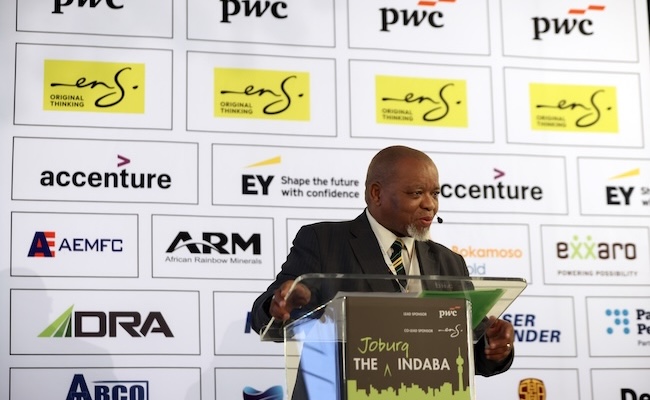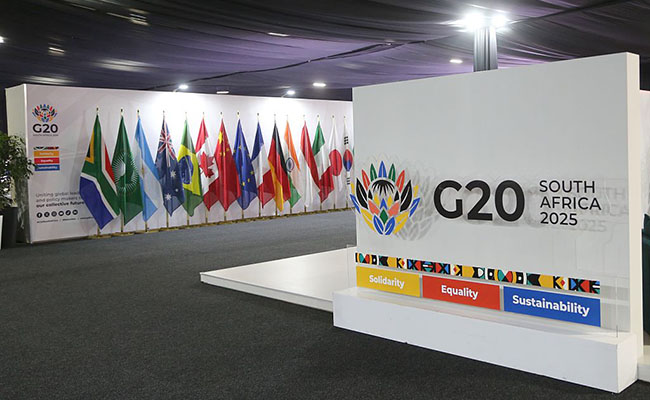Gwede Mantashe, South Africa’s coal-loving mining minister, was welcomed to the stage at the Joburg Indaba this week by a mischievous Bernard Swanepoel, the veteran former CEO of Harmony Gold.
“This is definitely his farewell speech, I smell political change,” said Swanepoel, tongue in cheek. “I think it’s time to get rid of Gwede.”
Many in the audience – specifically the mining executives – would have agreed with the sentiment. The new Mineral Resources Development Bill, gazetted in May, which seeks to force exploration companies to sell shares to Black investors, is a particular flashpoint.
But Mantashe laughed off the introduction, saying that while Swanepoel wants to “fire me this term”, he wants to finish serving as minister in President Cyril Ramaphosa’s administration, which is due to end after the next general election in 2029.
“This is my last term, allow me to finish my term,” he said, adding that at 70 years old, he is “too old now” to continue in the role beyond that.
During his hour-long closing address at the indaba, Mantashe spoke of how reports of the sun setting on South Africa’s mining industry are greatly exaggerated. “We should do everything to ensure that there is growth. This is evident in the second quarter performance, during which mining output grew by 3.7% [which] added 0.2% to [South Africa’s] GDP. Even more encouraging was that employment in the sector grew by 0.7%,” he said.
Mining, he said, is an “industry I love, an industry I know, and an industry that can be very abusive by the way, but it is very addictive”.
And yet, while mining does remain central to South Africa’s economy – employing 465,000 people, and contributing R43bn in tax last year, equal to 14% of all corporate tax collected – those very figures that Mantashe cited speak to an immense lost opportunity.
Mining firms globally have been making hay in recent years, as the gold price this week surpassed $4,000 an ounce for the first time – rallying more than 100% over the past five years. This is largely because investors, fearing that US President Donald Trump’s tariffs will push up inflation and weaken the dollar, have sought out “hard assets” like gold.
But other minerals have also climbed. Even platinum, of which South Africa is the biggest producer globally, has enjoyed a surprising rally in recent months to $1,653 an ounce, up 60% over the past five years.
‘Lost generation’
Today, South Africa, once the third-largest gold miner in the world, has largely depleted its gold reserves. But platinum, manganese, iron ore and chrome are still plentiful – and the country risks losing out on the boom thanks to shoddy policy by Mantashe’s government.
This was voiced eloquently by Duncan Wanblad, the CEO of Anglo American, South Africa’s one-time mining champion, who opened the indaba the previous day with some lacerating criticism. “South Africa is underexploited today because it had unsupportive policy for exploration in the last 20-odd years,” he said. “That is a generation of mines that has been forgone.”
Typically, it takes 17 years from the time of finding deposits to full production, he said.
Wanblad didn’t say as much – and he wouldn’t have, being the consummate diplomat who is now trying to engineer a merger with Canada’s Teck – but it is an unspoken question about whether Anglo American, launched in South Africa in 1917, wouldn’t have retreated from South Africa as rapidly as it has had local mining policy been less obviously destructive.
He said that without supportive policy, South Africa would struggle to get investment. “I am optimistic, but I have a very healthy dose of realism around this optimism too,” he said.
Wanblad, predictably, was eager to stress Anglo American’s continued link to the country, arguing that his “is a company that likes South Africa and the region”. New opportunities, he added, “could very well be in South Africa”.
But it was hard to square this remark with the repeated warnings from the indaba about the new mining law, the shifting sands of mining policy, and immense difficulty of navigating South Africa’s broken infrastructure to export any minerals.
Paul Dunne, president of the Minerals Council South Africa, which represents 90% of miners in the country, echoed Wanblad’s point. “The mining industry has been severely constrained during the past three decades by regulatory uncertainty, weak administrative processes, unnecessary delays in licencing authorisations as well as [unreliable] electricity supply,” he said.
Dunne said the new Mineral Resources Development Bill “does not encourage or sustain the growth and investment that the mining industry needs”. And, while the industry has lobbied government to change this, Dunne said talks are likely to be “protracted”.
The implication: new mining ventures will fail to launch until this is sorted out, at the very least.
This sort of impasse is a major disincentive, as Dunne pointed out that it costs about R20bn and takes 10 years to build a decent-sized mine. “Providers of capital will not put their money into risky investments where their returns are threatened by regulatory uncertainty, crime and corruption, and failing infrastructure,” he said.
Fork in the road
Many of the presentations by mining executives contained similar warnings, a dose of cold water at a time when the heady price of gold would have otherwise had investors dreaming big.
Wanblad, looking on the bright side, said that South Africa’s problems – infrastructure, rail, logistics, electricity, or a cadastral system – could be overcome. And if that happens, it could “open up investment again in exploration in South Africa”, he said.
But it’s a big if; you had the sense that this was more of an item on a wish list rather than an imminent possibility.
You’d think that Mantashe, who heard much of the second day’s events and who, pledging a mantra of growth, would know what has to be done. He certainly knows that whether the industry can fill its boots is entirely contingent on whether government does the right thing.
During his address, Mantashe said that in the past two weeks, he has met with a number of mining CEOs. “I asked them one simple question: are there any prospects for mining growing in South Africa?” he said. “They all gave me a similar response: that it depends what we do.”
Which is absolutely true. What will do the country no favours is another lost generation of opportunity.
Top image: Mineral and petroleum resources minister Gwede Mantashe. Picture: supplied.
Sign up to Currency’s weekly newsletters to receive your own bulletin of weekday news and weekend treats. Register here.














The ANC is incapable of doing the right thing for mining or anything else. Absolutely incapable!